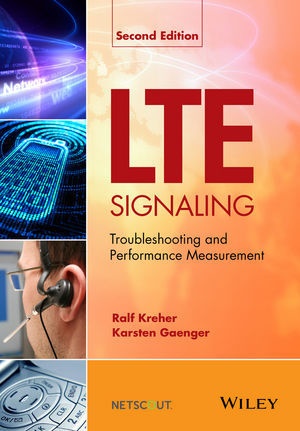Read more
"LTE Signalling, Troubleshooting and Performance Measurement describes the LTE signalling protocols and procedures for the third generation of mobile communications and beyond"--
List of contents
Foreword xi
Acknowledgements xiii
1 Standards, Protocols, and Functions 1
1.1 LTE Standards and Standard Roadmap 2
1.2 LTE Radio Access Network Architecture 9
1.3 Network Elements and Functions 10
1.3.1 The eNodeB (eNB) 11
1.3.2 Mobility Management Entity (MME) 12
1.3.3 Serving Gateway (S-GW) 12
1.3.4 Packet Data Network Gateway (PDN-GW) 13
1.3.5 Interfaces and Reference Points 13
1.4 Area and Subscriber Identities 18
1.4.1 Domains and Strati 18
1.4.2 IMSI 19
1.4.3 LMSI, TMSI, P-TMSI, M-TMSI, and S-TMSI 20
1.4.4 GUTI 21
1.4.5 IMEI 22
1.4.6 RNTI 22
1.4.7 Location Area, Routing Area, Service Area, Tracking Area, and Cell Global Identity 24
1.4.8 Mapping between Temporary and Area Identities for EUTRAN and UTRAN/GERAN-Based Systems 25
1.4.9 GSM Base Station Identification 27
1.4.10 UTRA Base Station Identification 28
1.4.11 Numbering, Addressing, and Identification in the Session Initiation Protocol 29
1.4.12 Access Point Name 30
1.5 User Equipment 30
1.5.1 UE Categories 31
1.6 QoS Architecture 32
1.7 LTE Security 34
1.8 Radio Interface Basics 38
1.8.1 Duplex Methods 40
1.8.2 Multiple Access Methods 42
1.8.3 OFDM Principles and Modulation 46
1.8.4 Multiple Access in OFDM-OFDMA 48
1.8.5 Resource Blocks 49
1.8.6 Downlink Slot Structure 53
1.8.7 OFDM Scheduling on LTE DL 56
1.8.8 SC-FDMA Principles and Modulation 60
1.8.9 Scheduling on LTE UL 62
1.8.10 Uplink Slot Structure 64
1.8.11 Link Adaptation in LTE 64
1.8.12 Physical Channels in LTE 70
1.8.13 Transport Channels in LTE 79
1.8.14 Channel Mapping and Multiplexing 80
1.8.15 Initial UE Radio Access 82
1.8.16 UE Random Access 82
1.9 Hybrid ARQ 87
1.9.1 Synchronous HARQ in LTE Uplink 90
1.9.2 Asynchronous HARQ in LTE Downlink 91
1.9.3 HARQ Example 92
1.10 LTE Advanced 94
1.10.1 Increasing Spectral Efficiency 95
1.10.2 Carrier Aggregation 95
1.10.3 Heterogeneous Networks 95
1.10.4 Inter-Cell Interference Coordination 97
1.11 LTE Network Protocol Architecture 98
1.11.1 Uu-Control/User Plane 98
1.11.2 S1-Control/User Plane 99
1.11.3 X2-User/Control Plane 100
1.11.4 S6a-Control Plane 100
1.11.5 S3/S4/S5/S8/S10/S11-Control Plane/User Plane 101
1.12 Protocol Functions, Encoding, Basic Messages, and Information Elements 102
1.12.1 Ethernet 102
1.12.2 Internet Protocol (IPv4/IPv6) 102
1.12.3 Stream Control Transmission Protocol (SCTP) 106
1.12.4 Radio Interface Layer 2 Protocols 108
1.12.5 Medium Access Control (MAC) Protocol 110
1.12.6 Radio Link Control (RLC) Protocol 111
1.12.7 Packet Data Convergence Protocol (PDCP) 115
1.12.8 Radio Resource Control (RRC) Protocol 117
1.12.9 Non-Access Stratum (NAS) Protocol 124
1.12.10 S1 Application Part (S1AP) 124
1.12.11 User Datagram Protocol (UDP) 128
1.12.12 GPRS Tunneling Protocol (GTP) 129
1.12.13 Transmission Control Protocol (TCP) 136
1.12.14 Session Initiation Protocol (SIP) 138
1.12.15 DIAMETER on EPC Interfaces 139
2 E-UTRAN/EPC Signaling 145
2.1 S1 Setup 145
2.1.1 S1 Setup: Message Flow 145
2.1.2 S1 Setup: Failure Analysis 147
About the author
Ralf Kreher, Tektronix Communications - Mobile Access, Berlin, GermanyRalf Kreher works as Senior Software Architect for Tektronix Communications (Test and Optimization) business with focus on UMTS and LTE Performance Measurement and Key Performance Indicator (KPI) implementation. Before joining the engineering department he lead the Tektronix Mobile Protocol Test Customer Training Department for almost four years being responsible for a world-class seminar portfolio for mobile technologies and measurement products. Kreher holds a Communication Engineering Degree of the University of Applied Science, Deutsche Telekom Leipzig. He is internationally recognized author of the books
UMTS Signaling and
UMTS Performance Measurement.
Karsten Gaenger, Tektronix Communications - Mobile Access, Berlin, GermanyKarsten Gaenger received a Dipl.-Ing. degree in electrical engineering from the Berlin University of Technology. He was with the Fraunhofer HHI research institute from 2004 to 2006. During this time he published several IEEE papers on his development of a reliable real-time streaming system and protocol for Mobile Ad-Hoc networks. His research interests are mobile communications, IPTV, and robust real-time video streaming. Currently he is with Tektronix, Inc. and takes part in the mobile test and optimization division for 3G and LTE networks. He is a Solution Architect with RAN focus for testing and monitoring real-time multi-media streaming in next generation mobile networks. His current projects include the development of a passive LTE air interface probe.
Summary
This extensively updated second edition of LTE Signaling, Troubleshooting and Performance Measurement describes the LTE signaling protocols and procedures for the third generation of mobile communications and beyond.

